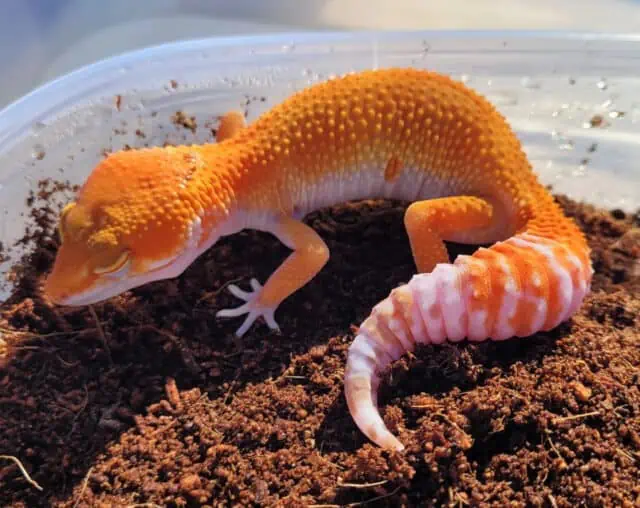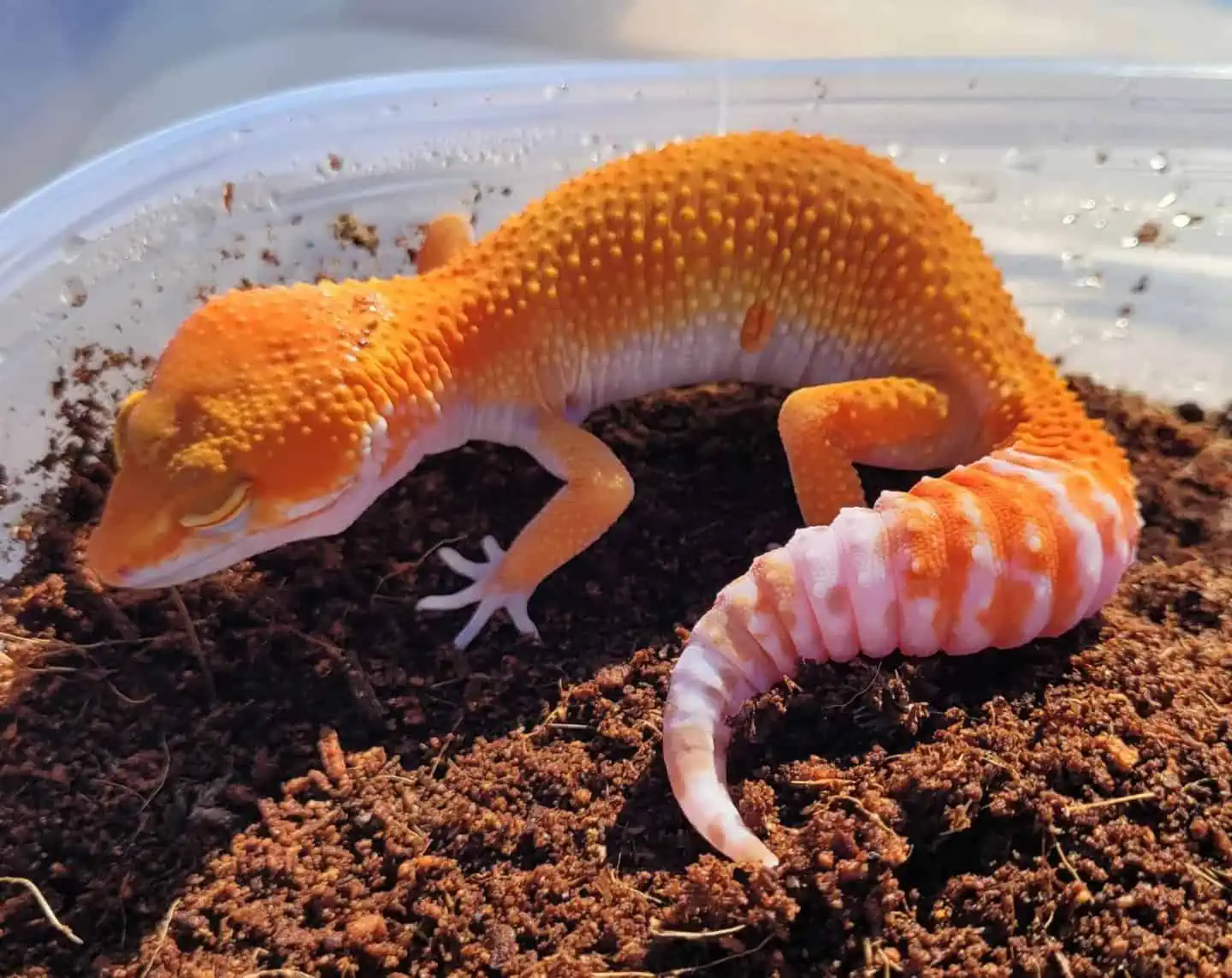The Sunglow Leopard Gecko, a distinctive morph, is known for its vibrant hues and easy-going nature. Originating from the arid regions of Afghanistan, Pakistan, and Northwestern India, this creature is a colorful variant of the common leopard gecko. Its distinctive “sunglow” trait is the result of selective breeding, aiming to amplify its enchanting yellow and orange tones.
This morph is renowned for being particularly amiable, making it a favorite amongst reptile enthusiasts. Leopard Geckos, by nature, are nocturnal, but the Sunglow variant seems to glow, even in the dim moonlight, a vivid reminder of the beauty found in the reptile world.
Distinct Appearance: Sunglow Leopard Geckos stand out with their vibrant coloration and unique physical features, like their movable eyelids and absence of sticky toe pads.
Ideal Pet Traits: Praised for being one of the best lizard breeds for handling, these geckos are friendly, relaxed, and quite tolerant—perfect for beginners.
Care Essentials: Proper habitat, temperature, and lighting conditions are vital. Coupled with their insectivorous diet, these conditions ensure the gecko’s well-being.
Breeding Know-How: To breed these geckos, it’s crucial to understand habitat setup nuances, pair compatibility, and optimal conditions for egg laying.

Sunglow Leopard Gecko: Quick Facts
| Fact | Detail |
|---|---|
| Morph Name: | Sunglow Leopard Gecko |
| Species: | Eublepharis macularius (Sunglow variant) |
| Lifespan: | 15-20 years |
| Size as an adult: | 8-10 inches |
| Diet is made of: | Insects such as crickets, locusts, and mealworms |
| Required Tank Size: | 20-gallon tank (for one gecko) |
| Temperature range: | 88-92°F (daytime) & 70-75°F (nighttime) |
| Humidity range: | 30-40% |
Are Sunglow Leopard Geckos Good Pets? Pros & Cons
Are Sunglow Leopard Geckos good pets? The answer is a resounding yes! Leopard geckos, with their tolerance for handling and ease of care, make for excellent companions. They are notably friendly and relaxed creatures, ranking them among the best lizard breeds for handling by owners of all experience levels.
Pros:
- Ease of Care: Sunglow Leopard Geckos have straightforward needs, making them suitable for both novice and experienced owners.
- Tolerance for Handling: They are known for their docile nature and willingness to be handled, fostering a strong bond between pet and owner.
- Long Lifespan: With proper care, these geckos can live up to 20 years, offering long-term companionship.
- Distinctive Appearance: Their vibrant, sunny coloration is captivating and adds an element of visual appeal to your home.
Cons:
- Specialized Diet: Being insectivores, they require a diet consisting mainly of insects, which may not be suitable for everyone.
- Specific Habitat Needs: They necessitate a carefully maintained environment, with particular temperature and humidity levels.
- Health Concerns: Like all pets, they can develop health issues that require veterinary attention and may incur additional costs.
While they do require thoughtful care and attention, the charming characteristics and manageable needs of the Sunglow Leopard Gecko make them well worth considering as pets.
What Do They Look Like? Appearance
Diving into the aesthetic world of the Sunglow Leopard Gecko, one is met with a symphony of vibrant colors and distinctive features.
These geckos stand out with their unique and radiant coloration, a mesmerizing mix of sunny yellows, soft oranges, and sometimes even pale pinks, with a lack of the typical dark spots seen in their common counterparts (such as Radar morphs, etc). This stunning coloration is what gives the morph its “sunglow” moniker. For another morph without spots, check out the Super Hypo Leopard Gecko.
Size-wise, adults usually measure between 8 to 10 inches, with a hearty and robust build. Their small stature and vivid hues make them an appealing choice for those looking to add a splash of color to their lives.
Beyond their stunning colors, Sunglow Leopard Geckos harbor unique physical traits that distinguish them from other gecko species. Remarkably, they possess movable eyelids, allowing them to blink and close their eyes while sleeping, a rarity among geckos.
Another distinguishing feature is their lack of sticky toe pads. Unlike their arboreal relatives, these ground-dwellers have small claws instead, aiding them in moving over rough terrain.
Sunglow Leopard Gecko Care Guide
Caring for a Sunglow Leopard Gecko involves a blend of proper environment setup, precise habitat conditions, and apt feeding and handling practices. Establishing a suitable living environment is paramount to ensure their well-being and longevity.
When setting up the habitat, consider a 20-gallon tank as a suitable space for one gecko. This provides ample room for exploration and exercise. Within this space, a gradient of temperature should be maintained. A basking area should have a temperature of around 88-92°F, while the cooler end should be around 70-75°F. Nighttime temperatures should never drop below 70°F. Heating pads or under-tank heaters are preferred as leopard geckos absorb heat through their bellies.
Lighting is another crucial element in their habitat. Though they are nocturnal and don’t require UVB lighting, a regular day-night cycle, simulated using a standard aquarium light, helps regulate their internal biological clock. Additionally, proper hides should be provided for resting and shedding.
Beyond habitat considerations, feeding is an integral part of Sunglow Leopard Gecko care. Being insectivores, their diet primarily consists of insects such as crickets, locusts, and mealworms. Feeding them a variety of insects ensures they receive all the essential nutrients. It’s important to gut-load the insects before feeding and occasionally supplement the diet with a multivitamin to maintain optimal health.
When it comes to handling, Sunglow Leopard Geckos are known for their tolerant and docile nature. However, handling should be gradual, allowing the gecko to acclimate to human interaction. Initial sessions should be brief, slowly increasing as the gecko becomes more comfortable. Always handle them gently, and avoid grabbing their tails as they can be dropped as a defense mechanism.
Sunglow Leopard Gecko – Ideal Diet
To ensure the health and happiness of a Sunglow Leopard Gecko, understanding their dietary needs is essential. These creatures are natural insectivores, thriving on a diet rich in insects, including crickets, locusts, mealworms, waxworms, and super worms. Offering a variety of insects is crucial as it ensures that the gecko receives a well-rounded intake of necessary nutrients, contributing to their overall well-being.
Before serving these insects to the gecko, they should be gut-loaded. This process involves feeding the insects a nutritious diet before they are offered to the gecko, ensuring that the nutrients are subsequently transferred. Gut-loading enhances the nutritional value of the insects, providing the gecko with a more balanced diet.
Beyond a varied and gut-loaded diet, occasional supplementation with a multivitamin is beneficial. This extra step ensures that any potential dietary gaps are filled, allowing the Sunglow Leopard Gecko to maintain optimal health. Sprinkling the multivitamin powder on the insects before feeding is a common practice, making nutrient intake seamless for the gecko.
Health Issues & How To Avoid Them
Leopard geckos, like any other pets, can encounter various health issues. Being aware of these and knowing the preventative measures can significantly contribute to the well-being of these creatures.
One common health issue is Metabolic Bone Disease (MBD), which is typically due to an imbalance in calcium, phosphorus, and vitamin D. Providing a diet rich in these nutrients and occasionally supplementing with calcium and vitamin D can help prevent this disease.
Another concern is impaction, caused by the ingestion of substrate or other indigestible materials. To avoid this, opt for a substrate that doesn’t pose an ingestion risk, such as reptile carpet or paper towels, and ensure that any food offered is of appropriate size and safe to eat.
Infections and parasites are also common amongst leopard geckos. Regular cleaning of the enclosure and proper hygiene, like washing hands before and after handling, can help in preventing these issues.
Monitoring for any abnormal behavior or physical changes is crucial as it can be indicative of underlying health problems. Early detection and prompt veterinary consultation can greatly aid in managing health concerns effectively.
Shedding problems are prevalent, usually owing to inadequate humidity. Maintaining proper humidity levels and providing a moist hide can alleviate shedding issues.
Breeding a Sunglow Leopard Gecko
Breeding Sunglow Leopard Geckos can be a rewarding experience but requires careful consideration and specific conditions to be successful. Understanding the process and ensuring optimal conditions are crucial for facilitating healthy breeding behaviors and ultimately, the production of healthy offspring.
The first step involves setting up an appropriate habitat. It should be spacious, clean, and well-structured, providing suitable hideouts and laying areas for the geckos. Correct temperature and lighting are essential, mimicking their natural environment to encourage breeding behaviors. A temperature gradient should be maintained within the enclosure, allowing the geckos to regulate their body temperature as needed.
Pair compatibility is also vital in the breeding process. Introduce a healthy male and a healthy female into the enclosure and closely monitor their interactions. It’s important to observe for any signs of aggression and separate them if necessary. Compatible pairs will exhibit mating behaviors, indicating a likelihood of successful breeding.
Once mating has occurred, provide optimal conditions for egg-laying. A secure, secluded area within the enclosure, equipped with suitable substrate, will offer the female a safe place to lay her eggs. Monitoring the female and ensuring she is healthy post-mating is vital, as is proper incubation of the eggs once laid.
How To Handle Sunglow Leopard Geckos
Sunglow Leopard Geckos are renowned for their friendly and relaxed disposition, making them ideal candidates for handling. However, approaching them with gentleness and patience is essential, especially with new geckos.
For newcomers, it is crucial to allow them ample time to settle into their new habitat before initiating any handling. A period of acclimatization helps in reducing stress and encourages the gecko to feel secure in its new environment.
Once the gecko seems comfortable, begin by placing your hand inside the enclosure for short periods, allowing the gecko to familiarize itself with your presence. Avoid sudden movements, and allow the gecko to approach your hand voluntarily. Gradual and consistent exposure will help in building trust between you and your gecko.
When the gecko appears at ease with your presence, gently pick it up by allowing it to walk onto your hand. Avoid grabbing or holding it tightly as it may induce stress. Keep initial handling sessions short, progressively increasing the time as the gecko becomes more accustomed.
While handling, it’s important to stay close to the ground to prevent any injury in case the gecko decides to jump or falls. Always supervise children when they are handling the gecko and teach them to be gentle and calm.





